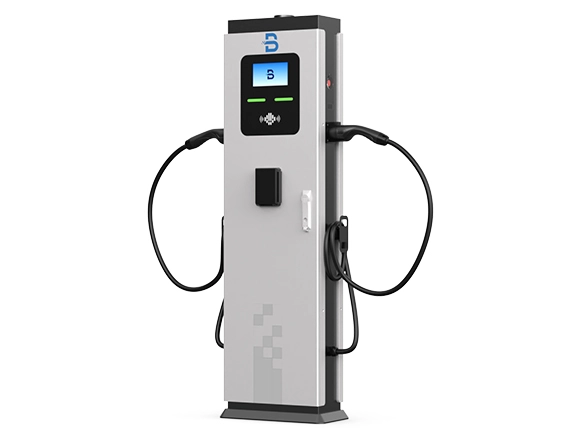Tragbares Ladegerät für Elektrofahrzeuge >
Tragbares Ladegerät für Elektrofahrzeuge >









Wir möchten Ihren Standort zu einer bevorzugten Wahl machen und das Parkerlebnis für Besitzer von Elektrofahrzeugen mit EVB-Ladestationen für Hotels verbessern. Unsere Ladestationen für Elektrofahrzeuge eignen sich nicht nur für Hotels, sondern für alle Bereiche des Gastgewerbes, wie z. B. Parkplätze von Einkaufszentren und Einzelhandelsgeschäften.
Die Ladelösungen von EVB für Hotels verbessern den Aufenthalt Ihrer Gäste. Wir bieten intelligente Ladestationen mit 7–22 kW Wechselstrom und 60–350 kW Gleichstrom sowie Fernverwaltung und Lastausgleich.
EVB-Ladegeräte wurden speziell für Hotels entwickelt und helfen den Häusern, mehr Gäste anzuziehen, zusätzliche Einnahmen zu generieren und Nachhaltigkeitsziele zu erreichen. Damit sind sie die ideale Wahl für Hotels, die ihre Annehmlichkeiten aufwerten.
EVB bietet fortschrittliche Ladelösungen für Elektrofahrzeuge für das Gastgewerbe und die Hotellerie und kombiniert intelligente Technologie mit hotelspezifischen Funktionen. Unsere Hotelladelösungen bieten dynamischen Lastausgleich, Solarkompatibilität und zertifizierte Sicherheitssysteme. Die integrierte Abrechnungssoftware vereinfacht den Betrieb. Wir kümmern uns um alles, von der professionellen Installation bis zum laufenden Support, und helfen Ihnen, Gäste zu gewinnen, Umsatz zu generieren und Nachhaltigkeitsziele mühelos zu erreichen.
Unsere Ladestationen für Elektrofahrzeuge in Hotels verfügen über eine dynamische Lastverteilung, die die Leistung automatisch anpasst, um den Energieverbrauch zu optimieren. Sie können auch mit Photovoltaiksystemen kombiniert werden, um den Benutzern günstigere Ladedienste anzubieten.
Die Leistung unserer Hotel-Ladegeräte für Elektrofahrzeuge wird regelmäßig geprüft, sie sind zertifiziert und entsprechen den neuesten Sicherheitsstandards. Sie verfügen außerdem über umfassende Schutzfunktionen, die die Sicherheit des Ladevorgangs erheblich verbessern.
Unsere EV-Ladegeräte für Hotels sind mit einer umfassenden Abrechnungssoftwarelösung ausgestattet. Unsere Software vereinfacht Abrechnung und Zahlungen und gewährleistet ein nahtloses Transaktionserlebnis für Ladestationsbesitzer.
Wir schicken professionelle Elektriker, die zunächst die Stromkapazität beurteilen, notwendige Upgrades durchführen und das System dann sicher und in Übereinstimmung mit den örtlichen Vorschriften für unsere EV-Ladestationen für Hotels installieren.
Die Installation von Ladestationen für Elektrofahrzeuge in Ungarn erhöht nicht nur den Komfort für Benutzer von Elektrofahrzeugen, sondern trägt auch zur Reduzierung der Kohlenstoffemissionen und zur Verbesserung der Luftqualität bei. Diese Initiative steht im Einklang mit den weltweiten Bemühungen um den Übergang zu umweltfreundlicheren Transportmöglichkeiten und spiegelt Ungarns Engagement für die Zukunft der Mobilität wider.
Die Installation von EV-Ladegeräten durch EVB in Portugal hat positive Bewertungen von Nutzern erhalten. Die Präsenz von EVB-Ladegeräten trägt zur Zugänglichkeit und Bequemlichkeit des Ladens von Elektrofahrzeugen im Land bei. Benutzer schätzen die Zuverlässigkeit und Effizienz von EVB-Ladegeräten, was sie zu einer vertrauenswürdigen Wahl für EV-Besitzer in Portugal macht.
Die Installation von AC-Ladegeräten für Elektrofahrzeuge in Perth verbessert die Zugänglichkeit und den Komfort für Besitzer von Elektrofahrzeugen und unterstützt den lokalen Übergang zu saubereren und energieeffizienteren Transportmöglichkeiten. Diese Ladegeräte tragen zur Reduzierung der Kohlenstoffemissionen bei und fördern die ökologische Nachhaltigkeit.
Mit über 30 Jahren Erfahrung entwickelt EVB Ladelösungen für Elektrofahrzeuge in Hotels mit flüssigkeitsgekühltem Gleichstrom-Schnellladen, Mehrport-Stationen und Energiespeicherintegration und passt sich an verschiedene Szenarien im Gastgewerbe an, um die Ladeeffizienz und den Umsatz zu steigern.

Dieses kleine 7-Zoll-DC-Schnellladegerät bietet eine Leistung von 60 kW bis 160 kW und ist IP55-zertifiziert. Bodenmontage mit 2 Pistolen (CCS1, CCS2, CHAdeMO GB/T NACS optional).

Dieses 21-Zoll-DC-Schnellladegerät bietet eine Leistung von 60 kW bis 320 kW und ist IP55-zertifiziert. Bodenmontage mit 2 Pistolen (CCS1, CCS2, CHAdeMO GB/T NACS optional).



Bietet Leistung von 82 kW bis 262 kW, Schutzart IP55. Bodenmontage mit 3 Pistolen (CCS1, CCS2, CHAdeMO, AC optional)



Unsere bodenstehende Ladestation für Elektrofahrzeuge für den Arbeitsplatz verfügt außerdem über einen Werbebildschirm zur Verbreitung der Nutzung. Dieses 60-kW-Gleichstrom-Schnellladegerät bietet einen Leistungsbereich von 60 kW bis 160 kW und ist mit zwei Pistolen ausgestattet.

EVB DC split charger system integrates a rectifier cabinet and charging terminal, offering efficient charging with capacities up to 720kW.The charging terminal has a maximum power of 500kW.

EVB DC split charger system is equipped with 1 gun charging terminal, which has a maximum power of 250kW.

DC EV Split-Ladegerät-Kit mit Gleichrichterschrank und Ladeterminal

Provides power from 40kW to 60kW, IP55 rated. Wall-mounted with charging outlets CCS1/CCS2/GBT/NACS/CHADEMO and dual connector.



The EVB Wall-mounted IP65 DC EV Charger 22kW is equipped with an impressive 5-inch touch screen that offers intuitive control, as well as comprehensive full protection features. Enjoy convenient app control and Ethernet/4G/WiFi connection, and charge your EV confidently and efficiently!



Liefert Leistung von 20 kW bis 40 kW, Schutzart IP54 mit einem Geräuschpegel von ≤ 65 dB. Wandmontage mit CSS2-Ladesteckdosen und Einzelstecker.


Entdecken Sie das EVB VoyagerPower 2.0 Air Cooling Energy Storage System, ein hocheffizientes Batteriespeichersystem in Containerform mit einer Kapazität von 1 bis 5 MWh für flexibles Energiemanagement in verschiedenen Anwendungen.

Die Integration des 50-kW/100-kWh-Solarenergiespeichersystems basiert auf dem „All-in-One“-Designkonzept, das Hybrid-Wechselrichter, Lithium-Ionen-Akku, Brandschutzsystem, Temperaturkontrollsystem, Lasten und Stromnetz integriert, um eine intelligente Energieverwaltung und -verteilung zu ermöglichen.

Das 100 kW/230 kWh starke Energiespeichersystem mit Flüssigkeitskühlung wurde von EVB eigenständig konzipiert und entwickelt. Es wird häufig im Bereich der Energiespeicherung mit netzgekoppelten und netzunabhängigen Wechselrichtern eingesetzt.

Das tragbare EV-Ladegerät von EVB ist eine praktische, tragbare Plug-and-Play-Möglichkeit, Ihr Elektroauto mit Strom zu versorgen.


AC-EV-Ladegerät mit EV-Ladebuchse Typ 2, wand- oder mastmontiert, funktioniert 1-phasig oder 3-phasig, also mit 230 V oder 400 V, 6 A oder 32 A. Funktioniert bei -25 °C bis 55 °C und ist CE-, CB- und RCM-zertifiziert, mit feuerfesten Gehäusen der Schutzklasse IP65 und V0.


Verbessern Sie Ihr Ladeerlebnis mit dem bodenmontierten AC-Ladegerät EVB mit POS-Funktion. Erleben Sie mühelose Interaktion mit dem 7,0-Zoll-Touchscreen. Steuern Sie Ihr Ladegerät über eine intelligente App und verschiedene Konnektivitätsoptionen.



Das auf Vielseitigkeit ausgelegte EVB 100 kW/241 kWh Luftkühlungs-Energiespeichersystem stellt die optimale Wahl für gewerbliche und industrielle Energiespeicheranforderungen im Außenbereich dar.

Der Schrank des Luftkühlungs-Energiespeichersystems mit 50 kW/115 kWh integriert Brandschutz, Klimatisierung und mehr. Seine schnelle Reaktion und vielseitigen Funktionen machen ihn an unterschiedliche Situationen anpassbar.

Verbessern Sie Ihr Ladeerlebnis mit dem bodenmontierten AC-Ladegerät für Elektrofahrzeuge EVB. Erleben Sie mühelose Interaktion mit der 5,0-Zoll-Touchscreen-Oberfläche. Steuern Sie Ihr Ladegerät über eine intelligente App und verschiedene Konnektivitätsoptionen.







AC-EV-Ladegerät mit Typ-2-Buchse, Wand- oder Mastmontage, funktioniert 1-phasig oder 3-phasig, also mit 230 V oder 400 V, 6 A oder 32 A. Funktioniert bei -25 bis 55 °C und ist CE-, CB- und RCM-zertifiziert, mit feuerfesten Gehäusen der Schutzklasse IP55 und V0.



Für alle unsere Ladegeräte gilt eine 3-jährige Garantie, einschließlich Fernwartung und Vor-Ort-Wartung.
Ihnen wird ein spezialisierter Account Manager zugewiesen, der Sie während des gesamten Produktionsprozesses auf dem Laufenden hält.
Zertifizierte Techniker installieren Ihre Ladestationen für Privathaushalte und geben Ihnen die Gewissheit, dass sie wie vorgesehen funktionieren.
Ein erfahrenes Support-Team steht rund um die Uhr telefonisch für die Anliegen der Kunden zur Verfügung.
Lebenslange Over-the-Air-Softwareupdates für Ihre Ladestationen sorgen dafür, dass diese ständig optimiert bleiben.
Von der Beratung bis zum Kundendienst sind wir bestrebt, Ihnen ein hervorragendes Serviceniveau zu bieten.

Wir verwenden intelligente Software zur Verwaltung von Informationen, um die Ladeleistung zu optimieren und auf intelligente Geräte zuzugreifen, um Folgendes anzuzeigen:
Zusammen mit unserem reaktionsschnellen Kundenservice sorgen wir mit den folgenden Services dafür, dass Sie Ihren Hotels weiterhin Ladedienste für Elektrofahrzeuge anbieten können:

Wir begleiten Sie Schritt für Schritt bei der Bereitstellung von Ladelösungen für die Zukunft. Befolgen Sie diese einfachen Prozesse.
Wir stellen Ihnen ein umfassendes Formular zur Verfügung, damit Sie Ihren bevorzugten Markt kennen und die beste Strategie für Sie entwickeln können. Das Format ist einfach; die Beantwortung dauert nur wenige Minuten.
Unsere Experten werden Sie kontaktieren und Ihren Bedarf an Ladestationen für Elektrofahrzeuge besprechen. Wir berücksichtigen die Details Ihres Marktbereichs und den besten Marketingplan für eine hohe Erfolgsquote.
Wir werden Spezialisten den zukünftigen Standort besuchen lassen, um die Rentabilität und das Potenzial des Standorts als Ladestation für Elektrofahrzeuge zu bestätigen und optionale Muster zur Überprüfung der Kompatibilität bereitzustellen.
Unser Produktionsteam beginnt mit der Produktion der kundenspezifischen Ladeeinheit gemäß den Spezifikationen der während des Besuchs gesammelten Informationen und berücksichtigt dabei den Markt und das Design für den Standort.
evB bietet einen Support- und Wartungsservice, der Sie bei der Wartung Ihrer Ladestation unterstützt und eine gute Beziehung für Ihre zukünftigen Geschäftsvorhaben aufbaut.
Von der Beratung bis zur Installation sorgt unser Expertenteam für eine umfassende, auf Ihre Bedürfnisse zugeschnittene Ladelösung für Elektrofahrzeuge.
Copyright © 2025, EVB. Alle Rechte vorbehalten.